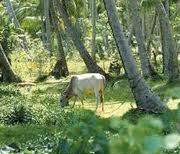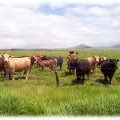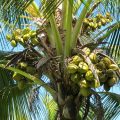 Small farms in the Philippines need not be disadvantaged in terms of productivity and earning power because of their size. To get the most out of a tract of land, a farmer can use his land as pasture for raising livestock or poultry while growing crops at the same time. Such a system, called integrated farming system, has seen success in a number of coconut farms in the Philippines.
Small farms in the Philippines need not be disadvantaged in terms of productivity and earning power because of their size. To get the most out of a tract of land, a farmer can use his land as pasture for raising livestock or poultry while growing crops at the same time. Such a system, called integrated farming system, has seen success in a number of coconut farms in the Philippines.
Aside from profitability and increased food production, raising livestock under coconuts is also an excellent way of saving money on weed control as weeds serve as pasture for cattle. However, in modern pasture-coconut agriculture, high yielding grasses and legumes are grown instead of native grasses, and this poses the disadvantage of competition for soil nutrients with coconut palms. To offset this problem and other problems regarding soil, pests and disease, a number of requirements has to be met.
In order to provide good anchorage for the coconut palm and keep it upright, the soil needs to have a depth of 90 cm or more. This depth will also allow for the storage of nutrients for both the coconut and the pasture crop. The soil must be properly drained to prevent water from accumulating in the rootzones and stunting the development of or killing off outrightly the crops. To insure better drainage of water, a light soil such as loam is best for pasture-coconut farms.
The soil must also be well aerated or have a good circulation of air. Because animal traffic effectively compacts the soil and reduces aeration, cultivation of the soil and/or the regulation of the stocking rate is necessary.
The choice of pasture variety affects the productivity of the coconut palms and livestock production. Such a choice must not favor one component of the integrated system (i.e. either the livestock or the coconut palm) but rather should be a compromise to gain maximum protection from both components. The factors that make a good pasture variety are adaptability to local climatic and soil conditions, tolerance to grazing or cutting, can be easily established, resistance to pests and diseases, has a high herbage yield, palatability and high digestibility, adaptability to local management practices. In addition, a good pasture variety should not be too competitive with coconut palms in terms of soil nutrients and should grow well even under low light intensities.
In pasture-coconut farms, several grass species and legumes have been tried. Of the grass species, para grass, guinea grass, and Alabang X were found to be satisfactory, while the legumes centrosema and kudzu were used with success. A number of other grasses and legumes have shown promise as pastures under coconut, although these have not been tried extensively as they were recently introduced to grassland agriculture.
The proper management of pastures include grazing control, soil amendments, mowing and disking. The amount of grazing depends on the type of grass or legume with different species requiring lenient to heavy grazing to allow for rapid regeneration of the pasture crop. For soil, the application of fertilizers as well as the nutrients nitrogen, phosphorous, and potassium should meet the nutritive demands of the coconut and pasture crops. Finally, the pasture must be mowed occasionally to ensure good pasture growth. The soil also needs to be broken up through disking or plowing to reduce soil compaction. This is done at intervals of four to five years.
Source: The Filipino Entrepreneur magazine






